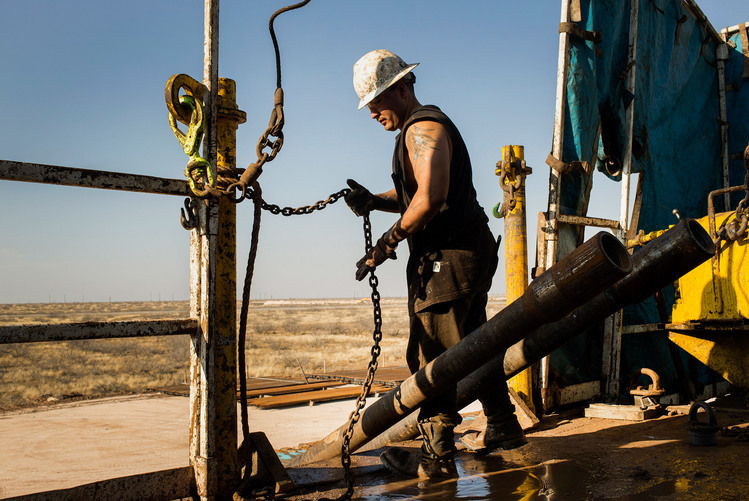
Those hoping the sector will hit its stride this year need to readjust their expectations, according to Houston’s top economist.
Patrick Jankowski, senior vice president of research and regional economist for the Greater Houston Partnership said: “For those things to get to a healthy level we are going to need $60 a barrel. There are companies out there that can make a profit at $50 and companies that make a profit at $40, but for recovery for the industry as a whole we are going to need to see $60 a barrel.
“Unfortunately, I don’t think we are going to see that until the end of this year or the first quarter of next year.”
However, he insisted the sector’s second wind was within reach.
“We’re limping along, hopefully by mid-year we’ll be a jog and maybe we will be sprinting by this time next year,” he said.
Part of the slowed recovery is the highly concentrated activity in the Permian Basin, which has seen a recent uptake but had untended cost repercussions.
He said:”The Permian basin is doing well just because the rock is so good there and there are so many layers there, which make it nice and economical.
“But the problem with Permian being one of the sole places is that anyone who has a rig is trying to move it there, so there is still lot of pressure on prices.
“What we would like to see is some of the service firms get back what they gave up in the downturn, but when I talk to people there is so much competition in the Permian with everyone moving their rig there is that they’re not seeing the pricing, especially for drilling, that they would hope to.
“What really need is to see the recovery be more broad basin. We need to see activity in other basins like the Marcellus.
“But even with this recovery, where we’ve doubled from the bottom and gone from 404 working rigs to 839,that’s still 1,000 rigs short of where we were before the downturn. So although, are looking up they are not to healthy level yet.”
Houston lost 81,000 energy job in the latest market dip.
“We’re lucky we’re in an economy with more than three million jobs. It did not devastate our economy. What it did when went from a sprint to a walk,” Jankowski said.
The city added nearly 20,000 jobs last year – all non-energy related, and saw an influx of 64,000 people. However, despite the surge it wasn’t enough to compensate for the loss of so many high-net earnings, according to the economist.
“The problem is the jobs in energy pay really well. The average compensation in the E&P sector is $150,000. The average compensation in a restaurant is $20,000,” he said.
“So net purchasing power has declined in the region even though the number of people living here has gone up.”
But a greater concern than the loss of spending power is the pinch on the horizon Jankowski can see starting to form.
Reports estimate $300billion of investment has been pulled from the sector, contributing to a loss of six million barres of oil per day (bpd).
Jankowski said: “My concern is that as wonderful as this unconventional production it’s not going to be enough to offset the growth in demand we are going to see a few years out and I could see us in three to five years being back into a really tight market with oil prices back up and us going through that cycle again.”
In the immediate short-term Jankowski expects OPEC to stay true to its cuts.
“I think when OPEC looks back at their decision they can see it did help the oil markets and did boost prices. We were trading at around $48 a barrel prior to OPEC’s agreement. Since then, we’ve been trading at $51 to $52, so OPEC’s agreement has had an output of between $3 to $5 per barrel.
“I think if they can keep it in place they can add another $3 to $5 a barrel.”
The Houston-based expert doesn’t see the uptake in the Permian detracting from the production curb.
“OPEC agreed to remove 1.2million a day and other countries combined totals roughly 600,000 barrels a day,” he said.
“The increase in US production has been 110,000 to 120,000 barrels. It’s been less than 10% of what OPEC agreed to cut. Even in the best case scenario I think Permian production would go up to 300,000 barrels this year. If that happens, it’s one-sixth of what the cuts are. I think OPEC will probably look back and see it’s a good thing and keep the cuts in place until the end of the year.”
So how we he know the sector has workings of a broad base recovery?
“That’s a simple answer,” Jankowski said.
The economist studied the earnings of 24 with large operations and representative of what the oil and gas business is in Houston.
“Last year only five made a profit and 19 lost money, when it flips and 19 made money and only five lost money, that tells me the industry has recovered,” he said.
“What it really comes down to is not the rig count or oil price but whether the firms can turn a profit.
People shouldn’t count oil out yet. Yes, we have renewables. Those are taking larger and larger roles in the energy mix, but we’re still going to need oil and natural gas well, well in to the future. There are some things you just cannot do with out. And you just can’t do without hydrocarbon based fuel.”
Recommended for you
